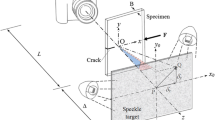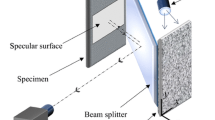Abstract
The paper presents a preliminary experimental investigation of crack-tip deformation fields near quasistatically and dynamically growing cracks in bimaterial interfaces. A three-point-bend bimaterial specimen with a relatively large stiffness mismatch between the two materials is studied. A recently developed optical method of coherent gradient sensing (CGS) is used to map crack-tip deformation fields.
The quasi-static measurements are interpreted using plane-stress, singular-field solution for the interface crack tip. Results are compared with two-dimensional finite-element computations performed on identical specimen geometries and material mismatch.32 Impact studies conducted with bimaterial specimens provide the first experimental results of deformation fields near dynamically growing cracks along interfaces. Very high crack velocities, up to 80 percent of the Rayleigh wave speed for the less stiffer material of the two, are observed.
Similar content being viewed by others
References
Williams, M.L., “The Stresses Around a Fault or Crack in Dissimilar Media,”Bul. of the Seismological Soc. of Amer.,49 (2),199–203 (1959).
Sih, G.C. andRice, J.R., “Bending of Plates of Dissimilar Materials with Cracks,”J. Appl. Mech.,31,477–482 (1964).
Rice, J.R. andSih, G.C., “Plane Problems of Cracks in Dissimilar Media,”J. Appl. Mech.,32,418–423 (1965).
Erdogan, F., “Stress Distribution in Bonded Dissimilar Materials with Cracks,”J. Appl. Mech.,32,403–410 (1965).
England, A.H., “A Crack Between Dissimilar Media,”J. Appl. Mech.,32,400–402 (1965).
Malyshev, B.M. andSalganik, R.L., “The Strength of Adhesive Joints Using the Theory of Crack,”Int. J. Fract. Mech.,1,114–128 (1965).
Comninou, M., “The Interface Crack,”J. Appl. Mech.,44,631–636 (1977).
Willis, J.R., “Fracture Mechanics of Interfacial Cracks,”J. Mech. Phys. Solids,19,353–368 (1971).
Knowles, J.K. andSternberg, R.L., “Large Deformation Near a Tip of an Interface-Crack Between Two Neo-Hookean Sheets,”J. Elasticity,13,257–293 (1983).
Shih, C.F. andAsaro, R., “Elastic-Plastic Analysis of Cracks on Bimaterial Interfaces; Part-I: Small Scale Yielding,”J. Appl. Mech.,55,299–316 (1988).
Zywics, E. andParks, D.M., “Elastic Yield Zone Around an Interfacial Crack Tip,”J. Appl. Mech.,56,577–584 (1989).
Rice, J.R., “Elastic Fracture Mechanics Concept for Interfacial Cracks,”J. Appl. Mech.,55,98–103 (1988).
Hutchinson, J.W., Mear, M. andRice, J.R., “Crack Paralleling an Interface Between Dissimilar Materials,”J. Appl. Mech.,54,828–832 (1987).
Liechti, K.M. andKnauss, W.G., “Crack Propagation at Material Interfaces: II. Experiments on Mode Interaction,”Experimental Mechanics,22,383–391 (1982).
Liechti, K.M. and Chai, Y-S., “Asymmetric Shielding in Interfacial Fracture Under In-Plane Shear,” EMRL Rep. No. 89/4, The Univ. of Texas at Austin (1989).
Chiang, F.P., Hua, L. andYan, X.T., “Photoelastic Analysis of a Crack at a Bimaterial Interface,” Advances in Fracture Research, Proc. ICF-7,4,3063–3072 (1989).
Tschegg, H.O., Kirchner, O.K. andKoyak, M., “Cracks at the Ferrite-Austenite Interface,”Act. Met. Mat.,38 (3),469–478 (1990).
Gao, H.C. and Evans, A.G., “An Experimental Study of the Fracture Resistance of Bimaterial Interfaces,” to appear in J. Appl. Mech.
Charalambides, P.G., Lund, J., Evans, A.G. and McMeeking, R.M., “A Specimen for Determining the Fracture Resistance of Bimaterial Interfaces,” J. Appl. Mech., in press.
Tippur, H.V., Krishnaswamy, S. andRosakis, A.J., “A Coherent Gradient Sensor for Crack Tip Deformation Measurements: Analysis and Experimental Results,”Int. J. Fract.,48 (3),193–204 (1991).
Tippur, H.V., Krishnaswamy, S. and Rosakis, A.J., “Optical Mapping of Crack Tip Deformations Using the Method of Transmission and Reflection Coherent Gradient Sensing: A Study of Crack Tip K-Dominance,” Caltech Rep. SM89-11 (1989). To appear in Int. J. Fract.
Krishnaswamy, S., Tippur, H.V. and Rosakis, A.J., “Measurement of Transient Crack Tip Deformation Fields Using the Method of Coherent Gradient Sensing,” Caltech Rep. SM90-1 (1990). To appear in J. Mech. Phys. Solids.
Nakamura, T., “Three Dimensional Stress Fields of Elastic Interface Cracks,” Proc. 11th Nat. Cong. of Appl. Mech., Tucson (1990).
Barsoum, R.S., “Three Dimensional Surface Singularity of an Interface Crack,” Int. J. Fracture (1990).
Liechti, K.M. and Chai, Y.S., “Three Dimensional Effects in Interfacial Crack Growth,” Proc. 11th Nat. Cong. of Appl. Mech., Tucson (1990).
Atkinson, C., “Dynamic Crack Problems in Dissimilar Media,” Mechanics of Fracture-4: Elastodynamic Crack Problems, ed. G.C. Sih, 230–248 (1977).
Brock, L.M. andAchenbach, J.D., “Extension of an Interface Flaw under the Influence of Transient Waves,”Int. J. Solids and Struct.,9,53–67 (1973).
Gol'dshtein, R.V., “On Surface Waves in Joined Elastic Materials and Their Relation to Crack Propagation Along the Junction,”Appl. Maths and Mech.,31,496–502 (1967).
Willis, J.R., “Self-similar Problems in Elastodynamics,”Phil. Trans. Roy. Soc.,274,435–491 (1973).
Rosakis, A.J. andRavi-Chandar, K., “On Crack-Tip Stress State: An Experimental Evaluation of Three-Dimensional Effects,”Int. J. Solids and Struct.,22 (2),121–134 (1986).
Rice, J.R., Suo, Z. andWang, J.-S., “Mechanics and Thermodynamics of Brittle Interfacial Failure in Bimaterial Systems,”Metal-Ceramic Interfaces, Acta-Scripta Met. Proc. Series,4,269–294 (1990).
O'Dowd, N.P. and Shih, C.F., private communications (April 1990).
Author information
Authors and Affiliations
Rights and permissions
About this article
Cite this article
Tippur, H.V., Rosakis, A.J. Quasi-static and dynamic crack growth along bimaterial interfaces: A note on crack-tip field measurements using coherent gradient sensing. Experimental Mechanics 31, 243–251 (1991). https://doi.org/10.1007/BF02326067
Received:
Revised:
Issue Date:
DOI: https://doi.org/10.1007/BF02326067




